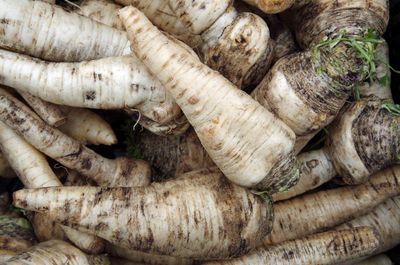


Parsnips with harvest-sized roots will usually have leaf stalks between 12 to 15 tall. You can begin to harvest parsnips earlier if desired (the roots will just be smaller). Radish seeds can be sown at a spacing of about 3cm, or Seed Tape can be used (or made) which ensures the spacing is even and consistent. Harvesting: Parsnip varieties take between 110 to 150 days to mature (this is another reason why it is perfect to grow them during the fall/winter in Texas).
GROWING PARSNIPS PATCH
To ensure this patch is as productive as possible, Tino is sowing Radish seeds into the rows between the Parsnip – they’ll shoot in less than a week, so the rows will be clearly defined. They will need to be thinned as they mature, to ensure the root development is spot on and develop well, but don’t rush to it – Parsnips take 120 – 180 days to mature! Parsnips will benefit from their soil being kept moist, so ensure a regular and consistent irrigation regime. Sow the seeds at 3cm spacings, in furrows 30cm apart. If youre planting your whole garden in rows with walking paths between each. The parsnip variety that Tino is sowing is “Guernsey” ( Pastinaca sativa “Guernsey”), and he recommends obtaining new parsnip seed each season, given the lower germination rates on older seeds. Once plants germinate, thin to about 8 cm apart. In Rome, parsnips used to be smaller, though the plant was originally the same. Parsnips were a luxury item for our Roman ancestors. It was definitely not the food, although sometimes that decadence took the form of great orgies of culinary madness. Parsnips need a loose, friable soil, but don’t mind it a little nutrient depleted, so they are the perfect follow-up behind hungry crops like potatoes and brassicas.īefore planting the parsnip seed, dig the soil over well to loosen and “fluff up” and then create some furrows – these are where the seeds will be sown, and will act to trap the water and disperse it to where it is needed most – the seedlings! It was decadence that brought down the Romans, history teaches us. They can take two to four weeks to germinate, and they need to develop well before the cool weather sets in. It’s a brilliant time to get root crops like turnip, radish, beetroot and carrots into the ground, and it is the absolute last chance to sow parsnip from seed before the weather gets too cool. Place the tops, root down in a glass of water. Parsnips are grown for their fleshy, edible, cream-colored taproots. When you’re cooking, just make sure to leave the top half inch (1 cm.) or so of the root attached to the leaves. The worst of the hot weather is behind us, and the soil is still warm, so Tino gives us some inspiration to get us out in the garden. The parsnip is a biennial plant with a rosette of roughly hairy leaves that have a pungent odor when crushed. March is a fantastic time to plant, whether it be seeds, seedlings, edibles, natives or planting out overgrown pots.


 0 kommentar(er)
0 kommentar(er)
